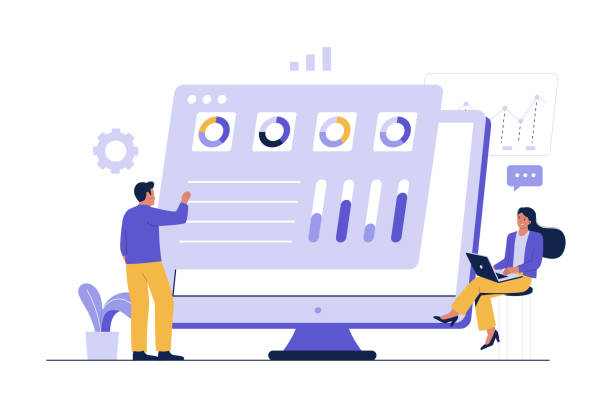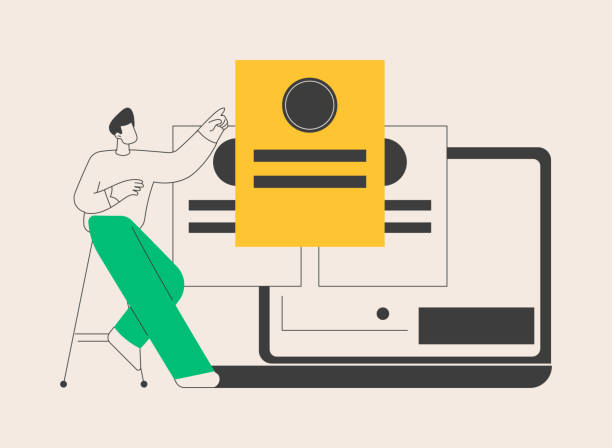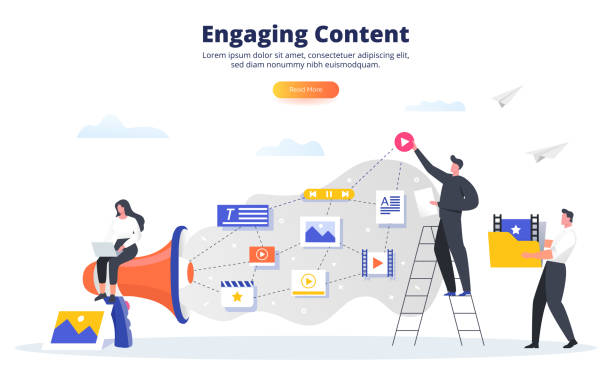An Introduction to Modern UI Website Design: The Cornerstone of Online Success

In today’s digital world, where competition for attracting and retaining user attention has peaked, modern UI website design is no longer a luxury choice, but a vital necessity.
This approach, beyond mere aesthetics, means creating a seamless and enjoyable user experience.
The main goal in #modern_website_design and #user_friendly_interface is not only to capture initial attention but also to retain the user over time and encourage more interaction with the site.
A website with poor UI/UX can quickly lose potential visitors, even if it has valuable content.
But a site with an excellent user interface invites users to explore more and significantly increases conversion rates.
This means success in commercial, educational, or informational goals.
Modern UI website design means utilizing the latest trends and best practices in visual design and interactivity.
This includes attention to fine details, from color palettes and typography to interactive feedback and intuitive navigation.
This approach ensures that every user, regardless of their technical knowledge, can easily and without confusion achieve their goal on the site.
This type of design is a foundation for creating a strong and lasting online presence.
Did you know that poor online store design can drive away up to 70% of your potential customers? Rasaweb transforms your sales with professional and user-friendly e-commerce website designs.
✅ Significant increase in sales and revenue
✅ Full optimization for search engines and mobile
⚡ [Get Free Consultation from Rasaweb]
Fundamental Principles of Modern UI/UX Design: The Path to Excellence

To achieve a truly outstanding modern UI website design, a set of fundamental principles must be adhered to.
The first and perhaps most important principle is minimalism or simplicity.
Clutter and adding unnecessary elements only distract the user and disrupt their experience.
A minimalist design, with ample white space and focus on key elements, ensures the main message is conveyed clearly.
The second principle is Responsiveness (Responsive Design); today, users access the internet from various devices, and the website must be perfectly viewable and interactive on any screen size, from mobile to desktop.
The third principle is Accessibility, meaning the site must be usable by all individuals, including those with disabilities.
This includes adhering to WCAG standards.
The fourth principle is Consistency in design.
Elements, fonts, colors, and interactions must be consistent throughout the site to prevent user confusion.
Finally, User-Centricity, meaning every design decision is made based on user needs and behaviors.
By adhering to these principles, modern UI website design can reach its peak and provide an unparalleled user experience.
Powerful Tools and Technologies for Creating Advanced User Interfaces
![]()
Today, the process of modern UI website design is facilitated by a set of powerful tools and advanced frameworks.
In the design and prototyping phase, tools like Figma, Sketch, and Adobe XD are leading the way.
Figma, with its real-time collaboration and web-based capabilities, has quickly become a popular tool for many designers.
Sketch, as a specialized vector design tool for Mac, still holds its place, and Adobe XD is used for its integration with other Adobe products.
These tools allow designers to quickly create complex designs, wireframes, and interactive prototypes, and even conduct initial user tests, which is a vital step in the process of any modern UI website design.
On the other hand, after design, it’s time for implementation.
JavaScript frameworks like React, Vue.js, and Angular enable the development of highly dynamic and interactive user interfaces.
These frameworks, with their specific design patterns and reusable components, accelerate development and simplify code maintenance.
Choosing the right tools and technology depends on the project, development team, and specific needs, but each of these plays an important role in creating a high-quality modern UI website design.
Sufficient technical knowledge in using these tools is essential for any team looking to create the best user experience.
| Feature | Figma | Sketch | Adobe XD |
|---|---|---|---|
| Platform | Web-based, Desktop (Windows, Mac) | Mac only | Desktop (Windows, Mac) |
| Team Collaboration | Real-time and online (very strong) | Requires plugins and cloud sync | Online collaboration (improving) |
| Prototyping Capability | Very powerful and interactive | Good, requires plugins | Powerful, with animation capabilities |
| Cost | Free (basic version), paid plans | Annual subscription | Included with Creative Cloud |
| Plugins/Community | Large user community, numerous plugins | Active user community, extensive plugins | Growing, integration with Adobe |
User Research and Personalization: Key to Understanding and Attracting Audiences

The foundation of any successful modern UI website design is a deep understanding of the target users.
User Research is a critical phase that helps designers identify the needs, wants, behaviors, and problems of their users.
This includes methods such as user interviews, surveys, statistical data analysis, and A/B testing.
By collecting this information, accurate User Personas can be created, providing a representation of real users with specific goals and needs.
These personas are the primary guide throughout all design stages.
Furthermore, the concept of Personalization is currently one of the main trends in UI design.
Personalization means tailoring the user experience based on each user’s preferences, history, and behavior.
For example, displaying relevant content, customized product suggestions, or even altering the layout based on geographical location or time of day.
This approach not only makes the user experience more enjoyable but also increases engagement and conversion rates.
A modern UI website design carefully implemented based on user data and with a personalization approach can significantly increase user retention and satisfaction.
Analytical understanding of data and transforming it into design solutions are among the most important aspects of this part of the process.
Research shows that 80% of customers trust companies with professional websites more. Does your current site inspire this trust?
With Rasaweb’s corporate website design services, solve the problem of customer mistrust and a weak online image forever!
✅ Create a professional image and increase customer trust
✅ Attract more sales leads and grow your business
⚡ Get a free consultation
The Magic of Animation and Interactivity in UI Design

In modern UI website design, animation and interactivity go beyond mere visual aesthetics; they act as guides, feedback providers, and engaging elements, significantly improving the user experience.
Subtle animations can draw the user’s attention to key points on the page, indicate the status of an action (e.g., content loading or successful form submission), or even aid in navigation between pages.
For example, a button that subtly changes color when clicked, or an icon that animates on mouse hover, can convey a sense of satisfaction and responsiveness to the user.
Microinteractions, which are very small interactions such as liking a post, providing feedback on a message, or even a subtle sound effect, can make the user experience more human and engaging.
However, excessive and inappropriate use of animation can have the opposite effect, distracting or even annoying the user.
The key to success in using these elements is balance and purposefulness.
Every animation should have a specific purpose and help the user perform a task or provide useful information.
When properly executed, animations and dynamic interactions can transform a static website into an entertaining and memorable user experience, playing a significant role in the effectiveness of modern UI website design.
These elements add depth and dynamism to modern UI website design.
Accessible and Inclusive Design: Ensuring User Experience for All

In modern UI website design, one of the most important responsibilities is ensuring Accessibility; meaning the website or application should be usable by all individuals, regardless of physical or cognitive abilities.
This is not just a good feature to add, but a fundamental right for users and, in many countries, a legal requirement.
Accessible design includes a wide range of considerations, such as providing alternative text for images (Alt-text) for visually impaired users who use screen readers, providing captions for video content for deaf individuals, ensuring sufficient contrast between text and background for visually impaired individuals, and enabling full keyboard navigation for those who cannot use a mouse.
Web Content Accessibility Guidelines (WCAG) published by the World Wide Web Consortium (W3C) are international standards to ensure web accessibility.
Adhering to these guidelines not only helps individuals with disabilities but also generally improves the user experience for everyone; for example, increased contrast can be beneficial for older adults or those in brightly lit environments.
A truly modern UI website design must be inclusive and not prevent any user from accessing information or services due to their limitations.
This approach is not only an ethical commitment for a designer but also enhances a brand’s credibility and covers a wider target market.
This aspect of design is the essence of a responsible modern UI website design.
Mobile-First Approach and Responsive Design: The Backbone of Modern Design

In the current era, where the majority of internet users access the web via mobile devices, the Mobile-First approach and Responsive Design are no longer just an option, but rather the backbone of any successful modern UI website design.
The Mobile-First approach means that the design and development process begins by focusing on the smallest screen (mobile) and then gradually scales up for tablets and desktops.
This method ensures that the most important content and functionalities of the site are presented optimally on mobile devices, where screen space and processing resources are more limited.
Responsive design refers to techniques where the website automatically adjusts its layout and elements to the user’s device screen size.
This includes the use of Flexible Grids, Flexible Images, and Media Queries in CSS to apply specific styles for different screen sizes.
For example, a navigation menu that is displayed horizontally on a desktop may collapse into a hamburger icon on mobile.
Failure to adhere to these principles can lead to a poor user experience, high bounce rates, and ultimately reduced online success.
Search engines also prioritize websites that are well-optimized for mobile.
Therefore, every modern UI website design must be developed from the outset with a Mobile-First approach and responsive techniques to ensure optimal performance and accessibility across all devices.
This aspect of design has strategic importance and should be at the heart of every modern UI website design project.
| Aspect | Mobile-First Approach | Responsive Design |
|---|---|---|
| Philosophy | First, we design and develop for mobile, then scale up for larger devices. | Designing a website that adjusts its layout for different screen sizes. |
| Starting Point | Smallest screen (mobile) | Any screen size (usually desktop to mobile) |
| Content Prioritization | Focus on core content and essential functionalities for mobile. | Aims to display content appropriately across all sizes. |
| Performance | Due to focus on optimization for limited devices, usually has better performance on mobile. | Can involve loading all desktop content which is then hidden on mobile. |
| Complexity | May initially require a rethinking of design philosophy. | More of an implementation technique performed after the overall design. |
The Future of UI Design: Innovations and Upcoming Challenges

The future of modern UI website design is constantly evolving, presenting new horizons for designers with the emergence of new technologies.
Artificial Intelligence (AI) and machine learning will play an increasing role in personalizing user experience, optimizing designs, and even automating parts of the design process.
AI-powered design tools can offer intelligent suggestions for layouts, colors, and fonts, significantly increasing designers’ workflow speed.
Voice User Interfaces (Voice UI) and chatbots are also becoming primary interaction channels, requiring designs that operate beyond the screen and focus on natural language and understanding user intent.
Furthermore, Augmented Reality (AR) and Virtual Reality (VR) are opening up new avenues for interactive and immersive experiences, bringing unique design challenges including 3D interface design and motion-based interactions.
The main challenge for designers in this future is maintaining a balance between technological innovation and fundamental human needs.
How can we use these technologies to create experiences that truly improve users’ lives, and not just to showcase technological capabilities? This is a question the modern UI website design community must answer.
Progress in these areas requires continuous preparation and training for designers to integrate new technologies into modern UI website design processes.
Are you concerned about your e-commerce site’s low conversion rate and not achieving your desired sales?
Rasaweb is your specialized solution for a successful e-commerce website.
✅ Significantly increase conversion rates and sales
✅ Professional and user-friendly design to satisfy customers
⚡ Ready to revolutionize your online sales? Get a free consultation!
Measuring UI/UX Design Success: Key Performance Indicators

After investing significant time and resources in modern UI website design, it is crucial to know whether these efforts have achieved the desired results.
Measuring the success of UI/UX design requires looking beyond aesthetics and focusing on Key Performance Indicators (KPIs) that directly impact user experience and business goals.
One of the most important of these indicators is the Bounce Rate, which shows how many visitors leave the site immediately after arriving.
A low bounce rate usually indicates an engaging and relevant user interface.
Conversion Rate, which refers to the percentage of users who perform a specific action (such as a purchase, registration, or download), is also a vital KPI.
A good UI/UX design should optimize the user’s journey towards these goals.
Time spent on site, number of pages viewed per visit, and the rate of Returning Users can also provide valuable information about the site’s attractiveness and usability.
Furthermore, collecting direct user feedback through surveys, interviews, and user tests helps to understand their satisfaction and identify weaknesses.
Web analytics tools like Google Analytics and Hotjar allow for precise tracking of these indicators.
Continuous analysis of this data and implementing Iterative Improvements is a fundamental approach to ensuring the effectiveness of a modern UI website design and achieving its objectives.
These evaluations allow us to see how a modern UI website design can be optimized.
Challenges and Best Practices in Modern UI Website Design

Despite all its advantages, modern UI website design is not without challenges.
One of the biggest challenges is maintaining a balance between aesthetics and functionality.
Sometimes, designers focus too much on visual effects and new trends, neglecting usability or simplicity.
A website might look beautiful, but if users cannot easily use it, it will be useless.
Another challenge is managing user expectations; given the rapid advancements in web technology, users expect every website to be fast, smooth, and responsive, and meeting these expectations requires high technical knowledge and design skills.
Also, adapting to continuous technological changes and design trends requires continuous learning and knowledge updates.
To overcome these challenges, adhering to best practices is essential: close collaboration between designers and developers from the outset to ensure the technical feasibility of designs; conducting frequent user tests throughout the design process to identify and resolve issues in early stages; and focusing on established UI/UX principles rather than simply following trends.
Continuous iteration and improvement based on user feedback and analytical data are also key to long-term success in any modern UI website design.
By considering these points, a modern UI website design can be created that is both beautiful and effectively achieves its goals.
Frequently Asked Questions
| Question | Answer |
|---|---|
| What is a modern user interface? | Modern UI refers to a design that utilizes new trends, simplicity, excellent user experience, and attractive visual elements. |
| Why is using a modern UI important in website design? | It leads to attracting and retaining more users, creating a sense of professionalism, improving user experience, and increasing conversion rates. |
| What are the main features of a modern user interface? | Simplicity, ample white space, legible typography, attractive and harmonious colors, subtle animations, and responsive design. |
| How is responsiveness related to modern UI? | Responsive design is an essential feature in modern UI that ensures the site displays well on all devices (mobile, tablet, desktop). |
| What is the role of typography in modern UI design? | Choosing appropriate fonts and using them correctly enhances readability and contributes to the site’s aesthetic appeal and visual identity. |
| What is White Space and why is it important in modern UI? | It is the empty space between various page elements, which helps improve readability, user focus, and creates a sense of cleanliness and order. |
| What is the benefit of using animations in modern UI design? | Subtle and purposeful animations can capture user attention, improve interaction, and make information transfer more engaging. |
| How can User Experience (UX) be improved alongside modern UI? | By understanding user needs, simplifying navigation paths, providing appropriate visual feedback, and easy testability. |
| Does modern UI always mean using bright colors? | No, modern UI can use a variety of color palettes, including dark colors; what’s important is choosing harmonious and brand-appropriate colors. |
| What are the current trends in modern UI design? | Use of Dark Mode, Neumorphism, Glassmorphism, scroll-based animations, and minimalist design. |
And other advertising services from Rasaweb Advertising Agency:
Smart UI/UX: A dedicated service for growth in click-through rate based on user experience customization.
Smart Advertorials: Professional optimization for increasing click-through rate using real data.
Smart Marketplace: A professional solution for increasing sales by focusing on optimizing key pages.
Smart SEO: A blend of creativity and technology for digital branding through user experience customization.
Smart Website Development: An effective tool for online growth with the help of marketing automation.
And over hundreds of other services in the field of internet advertising, advertising consultation, and organizational solutions.
Internet Advertising | Advertising Strategy | Advertorials
Resources
The Importance of User Experience in Website Design
Modern User Interface and the Future of the Web
Digital Transformation and its Impact on User Experience
Web Design in the New Era: Challenges and Opportunities
? Are you ready to transform your business in the digital world? Rasaweb Afarin, with expertise in secure website design and comprehensive digital marketing services, is your reliable partner for reaching the pinnacles of success.
📍 Tehran, Mirdamad Street, next to Bank Markazi, Kazerun Jonubi Alley, Ramin Alley No. 6




